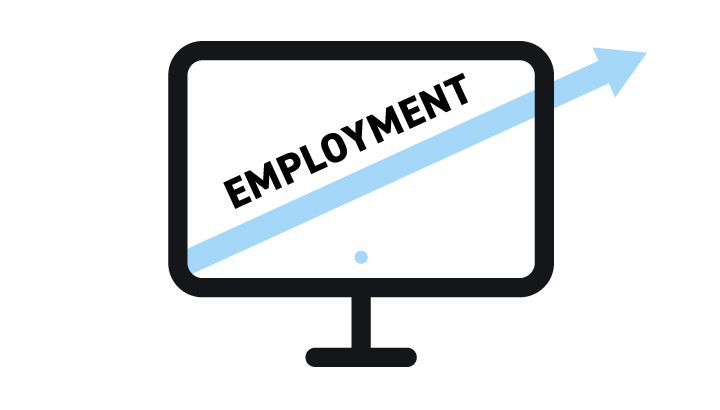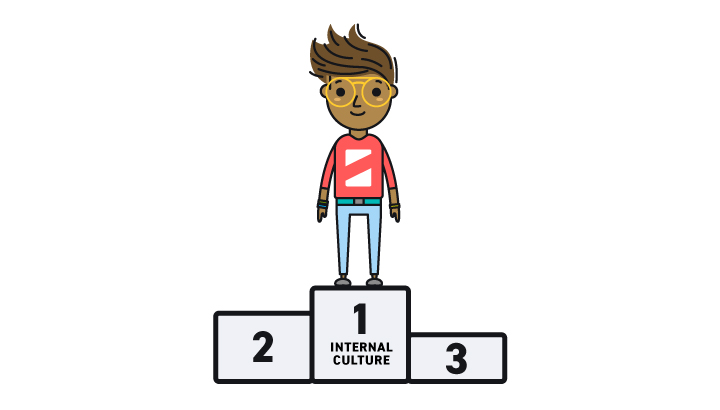It’s hard to find good help these days. Thanks to historically low unemployment, this cliché is the real deal - or is it? Employers need to adjust to the shifting balance of power in the hiring game because, in most markets, the workers have the upper hand.
Simply put, there are more jobs than skilled workers right now, so employers are scrambling to sweeten hiring incentives while adopting new recruiting techniques to try to find the help they need to get the job done.
Attention Employers: If you think it’s time to consider lowering your hiring standards, here are some creative tips from your favorite creative talent firm to help you find top talent in 2019.
Employment Trends in 2019

“The U.S. economy has become a seemingly perpetual job-generating machine, having steadily added workers for nearly eight years.”
~ Inc.
The Great Recession has passed and left us with historic unemployment and, so far, consistent job growth. More than two million jobs were added last year, according to Glassdoor, and unemployment dropped to 2% in many cities across the nation. While the demand for Front End and Back End Developers reached a frenzy, every employment field from healthcare workers to creative talent found themselves in a boom market. Last year, seven million jobs went unfilled. Fewer people are entering the workforce due to lower birth rates, and widespread retirement by the Baby Boomer population will free up even more jobs around the U.S.
Employers continue to scramble for top talent. Last year, 19 states increased their minimum wage and employers everywhere sought to improve benefits, according to U.S. News & World Report. Highly publicized wage increases by behemoths like Amazon may put pressure on competitors to follow suit.
Corporations are working harder to enact policies that improve the workplace. The #metoo movement, for example, brought new training on appropriate workplace behavior, which makes for a friendlier corporate work environment for women. Glassdoor says, “Diversity in the C-Suite has a long way to go, but the tide is changing.” Diversity is now a powerful trend that employers can leverage to bring in skilled workers.
But gaining cultural traction isn’t enough—employers must find new ways to source top talent, but they must also work to retain them. It’s a good time to consider new strategies and tactics for bringing on the employees that these companies need to fill orders and respond to customer demand.
Recruiting Advice from the Pros

In times of low unemployment, hiring should be a team sport. Companies must improve their recruiting strategies or fall behind. Today’s candidate-driven market demands that special attention be paid to all of the pieces of your HR puzzle. The truth is that talent picks you and not the other way around. So, candidate- and employee-centric tactics are the most effective way to continue building your organization.
Here are some important suggestions for improving your new hire process this year:
- Speed Up Hiring; Drop Old-School Application Portals
Corporations are still making big mistakes on the application process when it comes to bringing in new talent.
Employers that relax their standards enough to allow for less experienced employees with strong soft skills will win. Hiring less-than-perfect candidates and pairing them with mentors for on-the-job training will help employers fill more seats on the bus. - Make Onboarding Matter
Onboarding is the process of acclimating a new employee to their job and the people around them. Far from being a one-day process, the best onboarding programs establish mentorship or some other type of career support to help engage new employees in the success of the organization. Structured onboarding is a crucial part of the hiring and employment process; 58% of employees that go through a structured onboarding process are more likely to stay at a company three years or longer.
Find out more by reading “7 Tips for a Great Employee Onboarding Experience.” - Keep Your Existing “Customers” Satisfied
An important business rule is that companies grow by, first, retaining their existing customers and then, second, building a book of new business. In today’s employment market, employers should think of their employees as a type of customer that they must work hard to retain.
Employee engagement is rare these days. Gallup says there is a high likelihood that the majority of your employees are just not that into the work they’re doing. That could be because they’re not challenged by the work or because they feel they lack the responsibility to truly matter to the organization. Or it could be a negative relationship with their current boss or the working conditions themselves that cause the employee to withdraw and disengage.
Perhaps it’s the prevalence of poor workplace cultures, but today, more people are fleeing their jobs than ever before. Perhaps it’s because they simply have more job options. The statistics say there’s one thing we know: employees are taking new jobs in 2019 because they’re pursuing greener pastures. - Pay More Than the Competition
U.S. News & World Report says that employees who switch jobs often see the biggest salary increases. This makes it a forgone conclusion that your top employees are vulnerable to poaching by recruiters. ADP’s Workforce Vitality Report shows that worker wages increased by more than 3% last year, bringing the average employee wage to $28.06 per hour.
When was the last time you had your HR team conduct an analysis of your competitors’ benefits and salary offerings? If you’re not staying competitive, chances are you’ll lose your best to the company down the street.

- Improve Your Internal Culture
Culture is the number one factor enticing or scaring away job candidates, according to Glassdoor. The job board suggests, “Having a one-star or higher overall rating on Glassdoor attracts talent about six times the rate of paying $10,000 per year higher salary.”
Their point is that, although pay is important, it’s the culture of an organization that really matters. But what defines a work culture? Inc. says it’s hard to pin down, but “the cultural environment is the vibe of your organization and the actions that are taken to create that vibe or feeling.” They suggest that a good corporate culture is one where:
- Everyone feels valued
- Employees are proud of their work
- Workers feel a sense of belonging and purpose
- There is a team environment
- Diversity and inclusion are part of the corporate fabric
- Employees provide candidate referrals
- It’s a learning environment
- Employees are treated fairly
- Those in management coach and mentor their staff
- The company is devoted to health, wellness, and work-life balance

- Seek a Diverse and Inclusive Workforce
Glassdoor defines the difference between traditional diversity policies and today’s more inclusive workplace. The site says:
If diversity means having a more diverse workforce, inclusion means having a culture that ensures everyone is plugged into the organization—included in networking opportunities, on track for promotions, represented among company leadership, and so on. Belonging means feeling safe in the workplace to show your differences without being marginalized for them.
Employers today must move beyond traditional hiring practices in every area and expand their definition of diversity to include belonging and inclusion. This means they must make sure a diverse workforce is not only hired, but also engaged from day one. Why does this matter? Studies show that feeling socially accepted is a crucial part of employee retention.
When employees feel that they fit in, organizations reap the benefit of a fully engaged workforce that is comfortable contributing and feels respected when doing so. Top performing companies understand that the expansion of the diversity concept will bring a richer culture, more perspective, and increased productivity.
An important gauge of your internal temperature is whether your employees are referring candidates to your HR team. It helps, of course, if your company offers an incentive for referrals, but if you’re doing that—regularly asking for employee referrals—and still not receiving them, your culture may be serving as a wrecking ball to your best recruitment tactics. - Use Recruitment Marketing
Recruitment marketing is marketing designed specifically to attract new candidates. It’s a discipline that incorporates marketing from the perspective of the potential employee, promoting the corporate brand in a way that illustrates what’s in it for them. Each marketing piece, whether it’s a website video on corporate culture or a thought leadership podcast on top job skills to learn this year, should be geared toward attracting new employees. Recruitment marketing could include everything from a careers page on your website to a list of FAQs on why someone would want to work for your company. It’s an important way to both build your brand and highlight your culture when trying to land candidates before your competitors do. - Pay Attention to Social Media
A subset of recruitment marketing is social recruiting, or using social media to recruit new talent.
Social media offers both challenges and opportunities for employers. The challenge can be found on sites like Glassdoor, which allow candidates and employees to rank less than favorable interview or employer experiences. Hiring Managers and Social Media Specialists must consistently monitor employee reviews on these sites, responding when appropriate, and using the feedback to improve the hiring and employment environment.
But social recruiting isn’t all defense—these tools can be used offensively to emphasize corporate culture. Because we know that establishing a positive cultural reputation will attract new employees, social recruiting is a low cost but compelling way to build the brand of your hiring team and company. - Expand Your Targets
The Society for Human Resource Management (SHRM) suggests one of the top hiring trends this year is looking for soft skills, rather than concrete experience, and then investing the time in training employees who have potential. SHRM points out that these soft skills will positively impact corporate culture. Candidates with critical thinking skills, emotional maturity, and a positive attitude are valuable to organizations whether the candidate has one year of experience or 10 in their chosen field. Expanding your perception by loosening tight job requirements may mean you find a loyal employee from an untapped labor pool. - Open the Door to Flexible Work Arrangements
If you’re still making employees punch an on-site time clock, be aware that the rest of the world is leaving this model behind. The flexibility of contractor or freelance employment, as well as work-from-home arrangements are now generally accepted practice in many companies. Glassdoor points out, “Although this flexibility often comes at the cost of no benefits and unstable work hours, it’s ideal for already-employed workers who may be looking for extra income.”
SHRM agrees, citing flexible work arrangements as the new black for hiring models everywhere. Increasing wages and benefits is one thing, but allowing employees to work from home when a child is sick is an invaluable perk that actually may make the employee more productive. Not less.
Find out more by reading “Is Working from Home Really Productive?” - Offer Relocation
Glassdoor recently did a study on what entices job candidates to uproot and move for a new job. They found that higher pay and better corporate culture are the top reasons people “do a geographical,” or move to take a new job. For employers that can offer it, relocation packages can sweeten the deal for a highly in-demand candidate. Today, more than 60% of all U.S. companies offer this benefit, so if your company is considering an out-of-town candidate and you know they have other offers on the table, it’s likely relocation is a part of the perks offered. Relocation packages can clearly demonstrate that you’re an employer who takes care of your people. relocation is one of them. - Extend Your Reach with a Staffing Company
Finding talent in 2019 will take all of the resources you can find. That’s exactly why extending your reach into the community with an experienced staffing agency like Artisan Talent is so important. We offer a wide range of employment services that can run in tandem with your existing team to help you staff up during peak seasons, fill existing roles, or help you find talent when it seems the market has run dry.
Partnering with Artisan Talent immediately gives you access to a pool of expertise that we’ve spent years developing. Contact us for help staffing up on creative talent today.



/I%20Quit%20Reasons%20People%20Leave%20Jobs.jpg?width=436&height=255&name=I%20Quit%20Reasons%20People%20Leave%20Jobs.jpg)